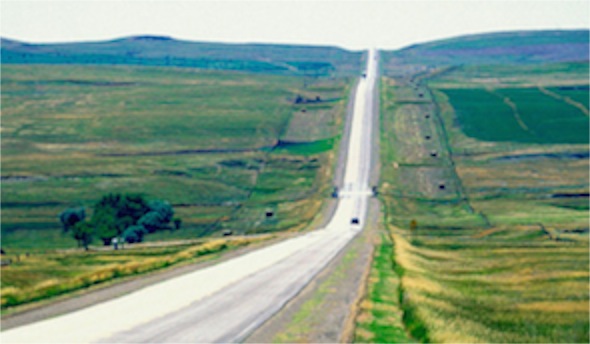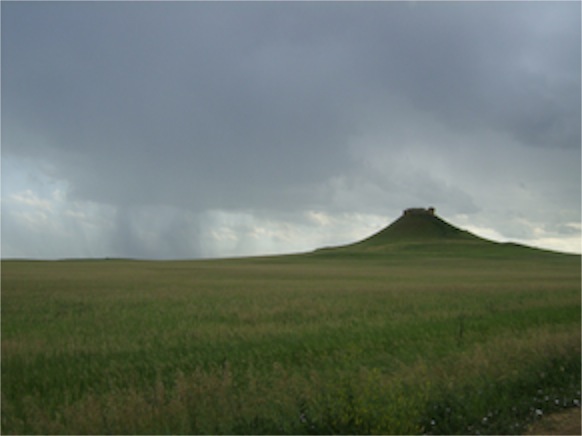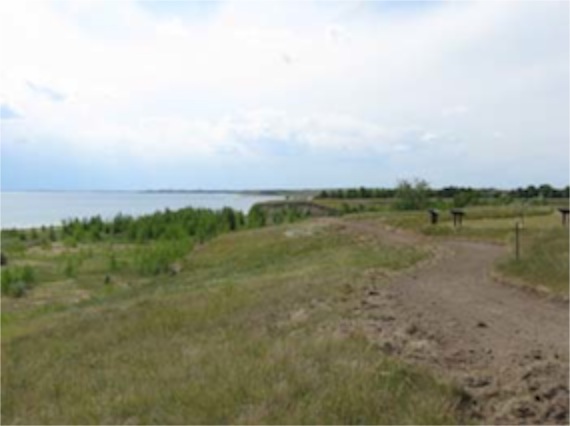North Dakota
08/08/12 04:39
My friends tell me that I pronounce the word “Dakota” differently when I say North Dakota as opposed to South Dakota. They say that the “o” sounds different, that I open my mouth wider and hold the vowel sound longer. They also tell me that I end the word “coda” instead of “cot.” I’m not sure that I can hear the distinction. I can put on a fake “Min-ee-so-da” accent and mispronounce words on purpose, but in my normal speech the word “Dakota” sounds the same to me each time I use it.
 They tell me that I pronounce the word like someone who has lived in North Dakota. Fair enough. We lived in North Dakota for seven years from 1978 to 1985. It was a wonderful experience. I enjoyed the place and I enjoyed the people a great deal. I grew up in Montana where people love to tell North Dakota jokes. The jokes are told in lots of different forms. They are the same stories that get told as Polish jokes, Norwegian jokes or other jokes on specific nationalities or places. Some of the jokes are even told as blond jokes. They are mostly mild jokes in which someone is portrayed as being less intelligent than others. Like this: Did you hear that they had to stop painting 911 on the police cars in North Dakota? The locals would see the 911 on the back of the car and steal it because they thought it was a Porsche. Another one reports that the telephone pole is the state tree of North Dakota and its state bird is the mosquito. You get the idea.
They tell me that I pronounce the word like someone who has lived in North Dakota. Fair enough. We lived in North Dakota for seven years from 1978 to 1985. It was a wonderful experience. I enjoyed the place and I enjoyed the people a great deal. I grew up in Montana where people love to tell North Dakota jokes. The jokes are told in lots of different forms. They are the same stories that get told as Polish jokes, Norwegian jokes or other jokes on specific nationalities or places. Some of the jokes are even told as blond jokes. They are mostly mild jokes in which someone is portrayed as being less intelligent than others. Like this: Did you hear that they had to stop painting 911 on the police cars in North Dakota? The locals would see the 911 on the back of the car and steal it because they thought it was a Porsche. Another one reports that the telephone pole is the state tree of North Dakota and its state bird is the mosquito. You get the idea.
On the other hand, my father was born and raised in North Dakota, and he always spoke of the state with respect and fond memories. He would be quick to point out that the state supported farm and ranch families during the Great Depression, that the State Bank and the State Mill and Elevator were two state institutions that demonstrated good governance. He would cite education statistics and tell us that North Dakota knew how to support schools and build good roads at the same time. North Dakota was the first state in the nation to complete its Interstate highway system, according to my father. He also could go on at length about how North Dakota had a fair tax system – better than any of its neighbors.
Whether or not this is true, the positive reports about the state were upheld by the experience of living there. The people are kind and caring and considerate of one another. They can be a bit slow to accept newcomers, but once you earn their respect, they are quick to show it. Despite the reputation, the weather is not bad. Yes, it can get cold in the winter. Yes, it was North Dakota that contributed the term “snirt” to the vocabulary. Snirt is a combination of snow and dirt that is driven through the air by high winds. But it is a state with incredible prairie beauty and the warmth of the people makes up from the occasional week of -30 weather.
We’re heading up north today on the first leg of the second part of our summer vacation. Susan will officiate at the wedding of a cousin later this week. The wedding will be outdoors at Strawberry Lake, one of the places that you need to know about in order to find. (Hint: it isn’t too far from Minot.) Of course the weather forecast is calling for thundershowers with a 70% chance of rain. In North Dakota, such a forecast is considered good luck. All rain is treasured, even the rain that comes during harvest.
 We’ve seen some storms in North Dakota over the years. One time, we were camping at Heart Butte Dam with our children and some friends. The clouds got so dark that we pitched our tents under a picnic shelter. It was a good thing. The wind and rain would have been a bit much for our small tents. We might have ended up sleeping in our cars. As it was the shelter provided a safe, dry place protected from the wind.
We’ve seen some storms in North Dakota over the years. One time, we were camping at Heart Butte Dam with our children and some friends. The clouds got so dark that we pitched our tents under a picnic shelter. It was a good thing. The wind and rain would have been a bit much for our small tents. We might have ended up sleeping in our cars. As it was the shelter provided a safe, dry place protected from the wind.
There is an occasional tornado in the state, but it lies north of tornado alley.
We have seen some pretty impressive blizzards over the years.
We’re camping on this trip, but we’ve upgraded from the days of tent camping. These days we have a slide-in pickup camper with a pop-top. That means that we have 2’ of tent canvas between the roof and the rest of the camper when the top is in the up position. The bed area is surrounded by canvas and much like sleeping in a tent, except the mattress is better and the roof is solid. There are limits to how much wind the structure will take, but we’ve had the camper for years and we know the limits well. We keep our weather radio handy and, on occasion, have retreated to a motel for the night when the forecast is for high winds. With the top in the down position, the camper has weathered really big winds and kept its contents secure.
 We’ll be spending a few nights at Fort Stevenson State Park. The park is on a spit of land beside Lake Sakakawea, the reservoir formed by the Garrison Dam across the Missouri. Yes, they spell the name of Sacagawea differently in North Dakota than they do in Montana. They pronounce it differently, too. The North Dakota way is closer to the way the Dakota people would have pronounced it. The Montana way is perhaps closer to the way the Shoshone would say it. No worries, Sacagawea was a Lemhi Shoshone who spoke both languages and English as well. She probably could speak more than a bit of French, too after marrying Toussaint Charbonneau. There is more than one way to pronounce the name of a worldly woman who was an interpreter and a guide. For the record, in Longview, Washington, there is another lake named for the same woman. They spell it “Sacajawea” out there.
We’ll be spending a few nights at Fort Stevenson State Park. The park is on a spit of land beside Lake Sakakawea, the reservoir formed by the Garrison Dam across the Missouri. Yes, they spell the name of Sacagawea differently in North Dakota than they do in Montana. They pronounce it differently, too. The North Dakota way is closer to the way the Dakota people would have pronounced it. The Montana way is perhaps closer to the way the Shoshone would say it. No worries, Sacagawea was a Lemhi Shoshone who spoke both languages and English as well. She probably could speak more than a bit of French, too after marrying Toussaint Charbonneau. There is more than one way to pronounce the name of a worldly woman who was an interpreter and a guide. For the record, in Longview, Washington, there is another lake named for the same woman. They spell it “Sacajawea” out there.
I’m looking forward to spending a few days in North Dakota. Up there no one thinks I have an accent.
By the way, blog posts may be a bit irregular for the next few weeks. We will be camping and I am not certain of Internet access. I’ll keep writing and post to the Internet when I am able.

On the other hand, my father was born and raised in North Dakota, and he always spoke of the state with respect and fond memories. He would be quick to point out that the state supported farm and ranch families during the Great Depression, that the State Bank and the State Mill and Elevator were two state institutions that demonstrated good governance. He would cite education statistics and tell us that North Dakota knew how to support schools and build good roads at the same time. North Dakota was the first state in the nation to complete its Interstate highway system, according to my father. He also could go on at length about how North Dakota had a fair tax system – better than any of its neighbors.
Whether or not this is true, the positive reports about the state were upheld by the experience of living there. The people are kind and caring and considerate of one another. They can be a bit slow to accept newcomers, but once you earn their respect, they are quick to show it. Despite the reputation, the weather is not bad. Yes, it can get cold in the winter. Yes, it was North Dakota that contributed the term “snirt” to the vocabulary. Snirt is a combination of snow and dirt that is driven through the air by high winds. But it is a state with incredible prairie beauty and the warmth of the people makes up from the occasional week of -30 weather.
We’re heading up north today on the first leg of the second part of our summer vacation. Susan will officiate at the wedding of a cousin later this week. The wedding will be outdoors at Strawberry Lake, one of the places that you need to know about in order to find. (Hint: it isn’t too far from Minot.) Of course the weather forecast is calling for thundershowers with a 70% chance of rain. In North Dakota, such a forecast is considered good luck. All rain is treasured, even the rain that comes during harvest.

There is an occasional tornado in the state, but it lies north of tornado alley.
We have seen some pretty impressive blizzards over the years.
We’re camping on this trip, but we’ve upgraded from the days of tent camping. These days we have a slide-in pickup camper with a pop-top. That means that we have 2’ of tent canvas between the roof and the rest of the camper when the top is in the up position. The bed area is surrounded by canvas and much like sleeping in a tent, except the mattress is better and the roof is solid. There are limits to how much wind the structure will take, but we’ve had the camper for years and we know the limits well. We keep our weather radio handy and, on occasion, have retreated to a motel for the night when the forecast is for high winds. With the top in the down position, the camper has weathered really big winds and kept its contents secure.

I’m looking forward to spending a few days in North Dakota. Up there no one thinks I have an accent.
By the way, blog posts may be a bit irregular for the next few weeks. We will be camping and I am not certain of Internet access. I’ll keep writing and post to the Internet when I am able.